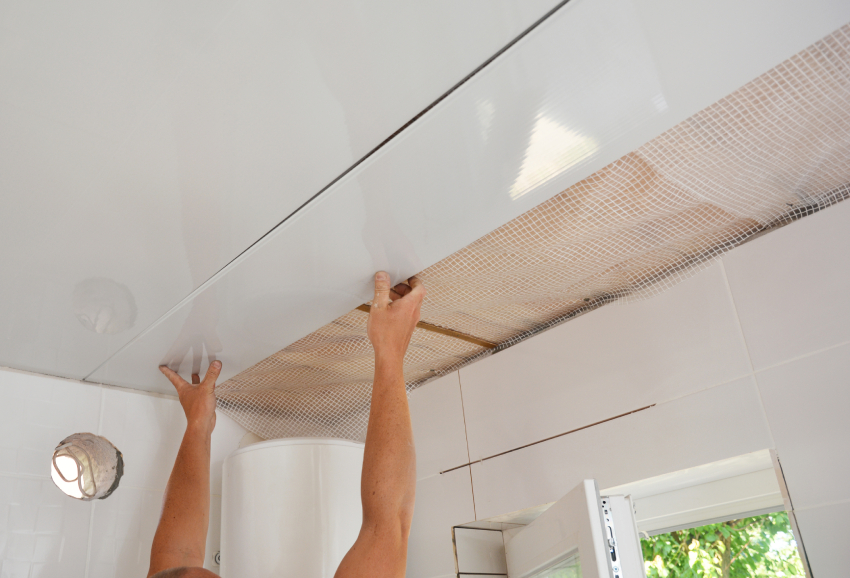What Is PVC Ceiling and Why It’s a Smart Interior Choice
If you’re planning an interior upgrade, you may be asking, what is PVC ceiling and where can it be used? A PVC ceiling is a lightweight, moisture-resistant panel system made from polyvinyl chloride. These panels are ideal for homes, commercial spaces, healthcare, and education buildings. They resist humidity, are easy to clean, and offer a neat finish.
Mada Gypsum supplies high-quality PVC facing tiles that match modern design requirements while delivering reliable performance. From kitchens to hospitals, PVC ceiling tiles help create clean, low-maintenance interiors.
PVC Ceiling Panel Designs for Modern Interiors
PVC ceiling panel design has improved in recent years. Panels now come in various styles, colors, and textures to match interior themes.
Common design options include:
- Smooth white or matte finishes
- Glossy panels for reflective surfaces
- Woodgrain and marble-look designs
- Perforated patterns for air movement
These designs help fit PVC into both minimalist and decorative interiors. Mada Gypsum offers PVC tiles suitable for grid systems or direct mount. Each tile matches standard sizes, ensuring easy fit and clean visuals.
How Long Does PVC Ceiling Last? Durability and Lifespan
You might wonder, how long does PVC ceiling last? When installed correctly and used indoors, PVC panels can last 10 to 20 years.
Lifespan depends on:
- Room conditions (humidity, temperature)
- Installation quality
- Type of panel used
- Regular cleaning (dust and stains)
Mada Gypsum’s PVC ceiling panel board is built for long-lasting performance. We test our panels for structural consistency and color retention under normal indoor conditions.
PVC Ceiling Panel Installation Guide: What You Need To Know
Installing a PVC ceiling is simple and efficient. Here’s a basic PVC ceiling panel installation guide for contractors and fit-out teams.
Steps include:
- Measure ceiling area and mark the layout.
- Fix wood or metal framing depending on ceiling type.
- Install PVC ceiling panel board using screws or clips.
- Cover joints with PVC strips or matching trims.
- Clean the surface after installation.
PVC Ceiling Work: Where and When To Use It
PVC ceiling work is best used in:
- Kitchens and bathrooms (due to moisture resistance)
- Commercial washrooms
- Hospital corridors and labs
- Cafeterias and service areas
It’s not suitable near open flames or direct high heat. For those areas, gypsum or cement board systems are a better fit.
PVC Ceiling Panel Size and Dimensions
Standard PVC ceiling panel size makes it easier to plan and install.
Typical PVC ceiling panel dimensions include:
- Width: 200 to 300 mm
- Length: 2.4 m to 6 m
- Thickness: 6 to 10 mm
Mada Gypsum’s PVC tiles come in consistent sizes with accurate edges, reducing waste and installation errors.
Advantages and Disadvantages of PVC Ceiling Panels
Every material has pros and cons. Here are the facts:
Advantages
- Lightweight and quick to install
- Water-resistant and easy to clean
- Affordable
- Available in many designs
PVC ceiling panels disadvantages
- Not suitable for high-temperature areas
- Lower sound absorption than gypsum tiles
- Can discolor over time if exposed to direct sunlight
Mada Gypsum ensures each panel meets performance requirements for indoor use. We recommend PVC tiles for areas where hygiene and moisture resistance are priorities.
Finding a Trusted PVC Ceiling Panel Supplier in Saudi Arabia
Choosing a reliable PVC ceiling panel supplier helps ensure your project stays on track. Look for a supplier who offers:
- Consistent panel quality and size
- Local stock availability
- Compliance with hygiene and fire ratings
- Technical support and product samples
Mada Gypsum is a trusted name in PVC ceiling work across Saudi Arabia. We supply PVC Facing Tiles designed for performance, hygiene, and easy installation.
Contact us today to request a quote or get technical guidance for your next project.

